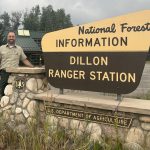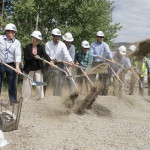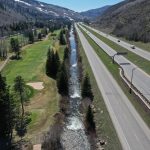Curious Nature: Where do the leaves go after they have fallen from the trees?
Daily Correspondent
Vail, CO Colorado
Fall is both one of my most and least favorite times of year. I really enjoy early fall, when the weather is warm and the hillsides are covered with a rainbow of yellow, red, green and orange leaves while the aspen trees and other plants are preparing for winter. I do not particularly like the part of fall that follows, when all the leaves have fallen from the trees. The hillsides are generally brown, and I begin to impatiently wait for the snow to come. However, for the forest this is an important time of year for reusing and recycling.
In the Eagle River watershed, aspen trees are the only deciduous or annual leaf-dropping trees we see on the hillsides. In one acre of an aspen forest, the trees can produce more than one ton of dry foliage every year. Yet when we visit these areas, we are not required to wade, knee deep, in the old accumulated aspen leaves. Where do the leaves go?
When I teach students at Avon Elementary about decomposition, we study nature’s FBI – fungus, bacteria and invertebrates. These tiny and often overlooked creatures are busy at work in late fall and fill a niche on which all other living things depend. As decomposers, fungus, bacteria and invertebrates actively break down dead plant and animal matter, returning nutrients to the soil.
Animals without backbones are called invertebrates and include worms, insects and their larvae and millipedes. These critters tend to be some of the first to feast on leaves after they have fallen to the ground. They start decomposition by breaking leaves into smaller pieces and consuming much of the biomass. However, their waste must be decomposed again by other members of the FBI before the process is complete.
On the forest floor, bacteria’s role takes place on a microscopic level as they work to help break down individual cells. Different kinds of bacteria also are found in the digestive systems of the invertebrate decomposers and help their bodies to break down the leaves.

Support Local Journalism
Mushrooms, a type of fungus, do the majority of the work in the decomposition process. The mushrooms found above ground are only the small reproductive part of the fungus organism. Underground, a mushroom is a widespread maze of root-like hyphae and mycelium. The hyphae are the part of the mushroom that actually digests the leaf matter in decomposition. The hyphae secrete an enzyme that breaks down the cell walls within the leaves, allowing the nutrients from the leaves to then be absorbed.
Once the mushrooms complete the initial decomposition of the leaves, the smaller invertebrates such as arthropods and worms eat the leaf pieces into tiny particles. They also eat old hyphae and the waste from other invertebrates to release the nutrients into the soil. The nutrients are then used by trees and plants as they grow. The whole decomposition process takes many years, and during this time, leaves at different stages of decomposition are found within the soil.
In different forest communities and regions of the world, decomposition takes place at various speeds. Environmental factors such as temperature, moisture levels, soil acidity and plant type influence how quickly decomposers can do their work. Decomposition occurs much slower in areas with especially dry or wet soils because these habitats are difficult for bacteria and fungi to survive. In general, broad aspen leaves break down faster than needles from fir, spruce and pine trees.
Although this is not my favorite time of year, I know it is essential for the survival of some of the most hidden inhabitants of this area. Without the FBI’s hard work in the late fall, I would not be able to enjoy the green grasses and healthy wildflowers found in aspen forests in spring and summer. The aspen tree leaves and decomposers that recycle them help to make the forests healthier for all who live there.
Lara Carlson is the community programs director at Walking Mountains Science Center. She can often be seen exploring the mountains with her dog at her side.










